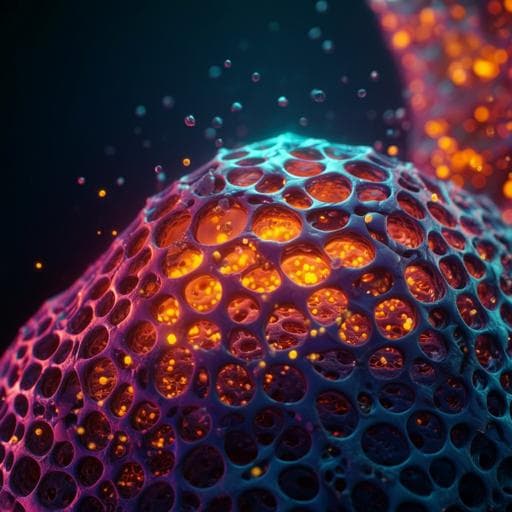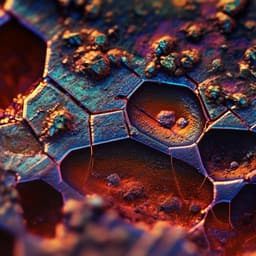
Chemistry
Atomic resolution tracking of nerve-agent simulant decomposition and host metal-organic framework response in real space
M. W. Terban, S. K. Ghose, et al.
Discover how metal-organic frameworks (MOFs) like UiO-67 can revolutionize chemical warfare agent filtration by effectively capturing and decomposing harmful substances. This groundbreaking research was conducted by an expert team that sheds light on the intricate interactions between MOFs and nerve-agent simulants.
~3 min • Beginner • English
Introduction
The study addresses how Zr-based metal-organic frameworks, specifically UiO-67, adsorb and catalytically decompose the nerve-agent simulant dimethyl methylphosphonate (DMMP). Prior work indicates Zr(IV)-oxo clusters act as Lewis acidic centers capable of hydrolyzing organophosphonates, producing phosphonic acid products that can bind to node sites. However, disentangling the roles of the ordered MOF lattice versus specific reactive defect sites (e.g., linker vacancies exposing Zr6 nodes) remains difficult. The authors aim to directly and simultaneously track guest uptake, binding, decomposition, and framework response at atomic resolution across length scales, to clarify the mechanism of sorption and decomposition in real time under relevant vapor conditions. This understanding is important for optimizing MOFs for chemical warfare agent capture/decomposition while mitigating issues such as re-emission, limited capacity, and disposal challenges.
Literature Review
Zr-MOFs have been highlighted as promising catalysts for CWA decomposition due to robust Zr(IV)-O nodes and Lewis acidic sites. DFT studies suggest hydrolysis proceeds via nucleophilic hydroxyl addition to form pentacoordinate P intermediates that rapidly decompose. Experiments (in situ XRPD, EXAFS, DRIFTS) on Zr-oxo cluster MOFs show adsorption of DMMP and decomposition to phosphonate products, notably formation of bidentate-bound methyl methylphosphonate (MMPA). Existing structural probes have limitations: diffraction-based electron density localization requires ordering, and modeling methods (SQUEEZE, MEM, DED) lose resolution through averaging; spectroscopies (SSNMR, IR, INS) are chemically informative but not directly refinable to structural models; EXAFS is element-specific and limited to near-neighbor shells. Pair distribution function (PDF) analysis leverages total scattering to access local to intermediate length scales without reliance on long-range order and has been used to study defects, amorphous MOFs, synthesis intermediates, temperature-driven node distortions, and guest binding to Zr-oxo clusters. The present work builds on this by applying in situ total scattering/PDF to track reactive changes in guest sub-structures and host response during DMMP exposure.
Methodology
- Material synthesis: UiO-67 synthesized by solvothermal reaction of H2BPDC and ZrCl4 in DMF (18 mL) at 80 °C for 24 h, followed by washing (DMF, anhydrous acetone) and vacuum drying at 90 °C for 8 h.
- In situ X-ray total scattering: Conducted at NSLS-II beamline 28-ID-2 (XPD) with 66.41 keV X-rays (λ=0.1867 Å), 2D PerkinElmer detector (~212 mm SDD). UiO-67 powder loaded in 1 mm ID polyimide capillary gas-flow cell with quartz wool plugs; He or DMMP/He delivered at 10 mL/min using a saturator at −40 °C for DMMP dosing. Temperature controlled by an Oxford Cryostream.
- Experimental sequence: I) Starting material at RT (30 min); II) Activation under He at 80 °C for 3 h (5 min frames), cool to RT (30 min); III) Reheating under He from RT to 80 °C in 5 °C steps; IV) DMMP/He flow at RT for 7.3 h (5 min frames); V) He flow at RT for 4 h (5 min frames); VI) Temperature ramp under He from RT to 80 °C in 1 °C steps (5 min per step); VII) Re-activation at 80 °C for 2 h under He (5 min frames). Longer 30 min scans between steps. Ni standard for calibration; empty cell background measured and subtracted.
- Data reduction and PDF: 2D images azimuthally integrated with pyFAI; corrections and background subtraction applied to obtain F(Q); Fourier transform (Qmin=0.3 Å−1, Qmax=24.0 Å−1) via PDFgetX3 within xPDFsuite to yield G(r). Real-space refinements with PDFgui; additional modeling and sequential analyses with custom Python codes using Diffpy-CMI.
- Average structure analysis: Rietveld refinements in TOPAS v6 using a UiO-67 model converted to F432 symmetry (single-occupation biphenyl torsion ~30°; removal of doubled oxygen sites). Refinement range 0.5–20° 2θ; parameters included global scale, Gaussian broadening, LP-factor=90, Chebyshev background (17th order) plus 1/X term. Zr, O, C Biso refined; linker occupancies allowed to capture BPDC vacancies. Sequential Rietveld refinements used to extract lattice parameters and guest site occupancies.
- Guest localization in diffraction: At maximum loading (end of step IV), introduced high-ADP pseudo-atoms (Dy, isoelectronic with DMMP) with positions/occupancies optimized by simulated annealing to map electron density in tetrahedral pores, octahedral pores, and cluster-coordinating sites. Pseudo-atom parameters then fixed; lattice, background, scale, and site occupancies refined sequentially for all datasets.
- Difference-PDF (dPDF) analysis: For each step, fitted the starting-step PDF plus a low-frequency sine term (to account for density modulation) to subsequent PDFs; dPDFs capture pair distances associated with added/removed guest and guest–cluster correlations. Also analyzed dPDFs referenced to activated state.
- Component fitting: Two models for the non-framework signal: (1) reference PDF + sine term + three Gaussian peaks to track features near ~1.5, 2.6, and ~3.4–3.5 Å; (2) reference PDF + sine term + simulated dPDF components (normalized) from DFT for free DMMP, monodentate MMPA, and bidentate MMPA with refined scale factors to follow relative contributions over time.
- DFT simulations: VASP 5.4.1, PBE functional, PAW potentials, 540 eV cutoff, Γ-point sampling, relaxed to max force ≤0.02 eV/Å. UiO-67 cubic unit cell with a missing-linker defect; under-coordinated Zr saturated with hydroxo/aqua ligands pre-exposure; DMMP replaces an aqua ligand upon binding and decomposes to MMPA per prior mechanisms. Simulated PDFs and dPDFs generated for isolated DMMP, DMMP bound monodentate, MMPA monodentate, and MMPA bidentate states (with/without counting bridging O as part of guest) to identify diagnostic pair distances (e.g., P–Zr).
Key Findings
- Framework thermal response: Slight negative thermal expansion (NTE) observed for activated UiO-67 between ~30–80 °C with volumetric NTE coefficient ≈ −10.78(8) MK−1. Activation under He led to a small lattice contraction (~0.01 Å, ~0.04% in a) reversible upon cooling.
- DMMP uptake and expansion: Upon DMMP dosing at RT (step IV), lattice parameter increased rapidly then gradually to a ≈ 26.95(7) Å, corresponding to ~0.376% increase in a and ~1.14% volume increase (consistent with prior ~1.17% volumetric increase). Bragg 111/200 intensities decreased, indicating reduced framework–pore scattering contrast due to guest filling.
- Site occupation from pseudo-atom mapping: At maximum loading, DMMP electron density localized to tetrahedral pore bulk (highest), octahedral pore bulk (about half of tetrahedral), and cluster-coordinating sites (about one-third of tetrahedral). Minimal removal from pore bulks during RT He flow (step V); removal increased upon heating (step VI), with steps near ~55 °C and ~70 °C suggesting distinct desorption regimes. Residual electron density remained at tetrahedral and cluster-coordinating sites after re-activation at 80 °C, paralleling a larger final lattice parameter than the initially activated state.
- TGA corroboration: Independent thermogravimetry confirmed adsorption/desorption behavior; all adsorbed content removed by ~120 °C without clear boundary between unreacted DMMP and decomposition products.
- Local structural signatures in PDFs: New short-range peaks at ~1.5 Å and ~2.6 Å grew during dosing (free DMMP intramolecular distances), along with a feature near ~3.5 Å indicative of P–Zr correlations from bound species. During heating, features at ~1.5 and ~2.6 Å diminished (loss of free DMMP), while the ~3.5 Å feature persisted, evidencing retained bound decomposition products.
- Binding state evolution from component fits: The Gaussian peak near ~3.5 Å shifted from ~3.50 to ~3.39 Å over the experiment, aligning with DFT P–Zr distances for monodentate MMPA (~3.502 Å) evolving toward bidentate MMPA (~3.412(3) Å). Component fitting favored free DMMP during dosing; bound DMMP was negligible compared with bound MMPA signatures. Heating promoted a shift from monodentate-like to bidentate-like binding.
- Persistent bound product: Bound MMPA remained after re-activation at 80 °C, indicating irreversible binding at Zr6 nodes associated with linker-vacancy defects; final bound fraction was relatively small, likely reflecting the limited number of vacancies (~1–3 per node by refinement).
- Zr6 cluster response: Experimental nearest-neighbor Zr–Zr distance ~3.521(4) Å (consistent with DFT average 3.53(2) Å) changed only subtly during dosing and desorption; observed variations likely reflect a combination of pore-content-induced strain and increasing bidentate binding, without strong distortions to Zr–Zr distances. P–Zr dPDF signals are clearly distinct from Zr–Zr contributions.
- Pore preference: Preferential occupancy of tetrahedral cages over octahedral cages corroborates predictions for hydrocarbons in UiO-67 and general tendencies for guests to occupy smaller accessible pores first.
Discussion
The integrated in situ total scattering/PDF and DFT approach disentangles guest uptake, binding/decomposition chemistry, and host framework response in UiO-67 under DMMP vapor. The lattice expansion quantified during dosing, together with decreased pore–framework contrast and pseudo-atom site mapping, demonstrate rapid pore filling with a preference for tetrahedral cages. dPDF analysis isolates guest-specific signals: growth of ~1.5 and ~2.6 Å features confirms free DMMP accumulation, while the emergent ~3.5 Å feature directly evidences P–Zr correlations from bound phosphonate species. The persistence of the ~3.5 Å feature during thermal desorption, coupled with the shift of the P–Zr distance toward ~3.39 Å, indicates fast conversion of DMMP to MMPA and progressive relaxation from monodentate to thermodynamically favored bidentate binding upon heating and re-activation. The small overall change in the Zr–Zr nearest-neighbor distance suggests that binding/decomposition does not significantly distort the Zr6 nodes under these conditions; observed variations likely arise from a balance between internal strain due to pore loading and the development of stronger bidentate binding states. The data also suggest that at RT He flow primarily removes weakly held pore-bulk DMMP, while elevated temperatures are required to efficiently desorb more strongly interacting molecules; the weak NTE of UiO-67 may contribute to expelling unreacted DMMP at higher temperatures. Overall, the findings validate the hypothesized mechanism of DMMP adsorption followed by decomposition to bound MMPA at defect-exposed Zr sites and quantify the temporal evolution of binding states in real space.
Conclusion
This work introduces and validates an in situ total scattering/PDF methodology, assisted by DFT, to resolve atomic-scale processes of guest uptake, binding, decomposition, and host response in MOFs across Å-to-nm length scales. For UiO-67 exposed to DMMP, the study reveals rapid pore filling with preferential occupancy of tetrahedral cages, substantial framework expansion (~1.14% volume), and conversion of DMMP to irreversibly bound MMPA that evolves from monodentate to predominantly bidentate binding upon heating. The approach enables simultaneous tracking of lattice changes, guest site occupancy, guest–node correlations (P–Zr), and subtle node responses (Zr–Zr distances) under realistic vapor conditions. As a blueprint, these methods can accelerate mechanistic elucidation and targeted design of MOFs for CWA capture/degradation and other applications. Future work should examine MOFs with controlled defect densities and types to enhance binding signal visibility, explore broader temperature/humidity regimes, and refine component models to encompass distributions of binding geometries and interactions with specific linkers.
Limitations
- Detection sensitivity for bound species is limited by the relatively small bound fraction, likely due to a low density of linker vacancies in the sample; stronger binding signals would be obtained from more defective materials.
- The component-model normalization (for fitting simulated dPDFs) is challenging; thus, extracted scale factors are interpreted qualitatively for trends rather than as absolute populations.
- DFT models employed terephthalate linkers (UiO-66) for practicality, omitting explicit correlations with UiO-67 BPDC linkers; linker–guest correlations were not included in simulated dPDFs.
- Separation of binding-specific node distortions from overall framework strain is nontrivial since Zr–Zr signals are averaged over affected and unaffected clusters.
- Experiments were limited to temperatures up to 80 °C in situ (with separate TGA to 120 °C), and the study did not systematically vary humidity or defect concentrations.
- The modeling is not exhaustive; a more detailed treatment of distributional local states and potential multiple binding motifs could further improve fits.
Related Publications
Explore these studies to deepen your understanding of the subject.







